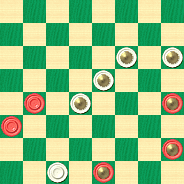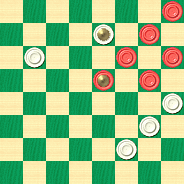The Checker Maven
Jump to navigationSixth
Alex Moiseyev is the reigning World Champion of 3-Move Restriction Checkers, the sixth in a line stretching back over seventy years to the first generally acknowledged 3-Move World Champion, Asa Long. However, with the notable exception of Derek Oldbury, these champions didn't write instructional books about checkers. Mr. Moiseyev has changed all that with his recent book, appropriately titled Sixth, with the subtitle Volume 1: The Way to the Crown.


World Champion Alex Moiseyev and his book "Sixth"
At first glance, the book looks like a college textbook: it's a sturdily constructed hardcover, nearly 400 pages in length, with the printed paper over boards casing style adopted by many text publishers. In fact, the book is in a way an advanced checkers text, though it's far too entertaining and lively to have been published by the typical publisher of college texts.
The book was printed and bound in the Ukraine, perhaps as an economy measure, and our only complaint is that the inking in our copy is uneven, with some pages dark and others quite light. But it's the content that matters, and that really shines.
Mr. Moiseyev presents two complete World Championship matches; his encounter with Ron King in 2003, and his contest with Elbert Lowder in 2002. He also gives us a selection of fifty of his best games from the 1996-2004 timeframe. The games are illustrated and annotated in a way seldom if ever seen in a checker book. Each page has at least one diagram, often more, and diagrams are always near the text section in which they are referenced, making for extraordinary ease of use.
In total, the book contains over 500 diagrams, presents 114 games, and treats 66 openings directly and 114 more indirectly. And you won't want to miss Mr. Moiseyev's coverage of the 3-Move World Championship Title controversy, which stretched out over the 2001-2003 time period. Checkers too has its moments of drama!
But when it comes to analysis of play, which is the real heart of the book, Mr. Moiseyev left no stone unturned. In addition to his own elucidations, he adds commentary and analysis by notables such as Richard Fortman; and finally, he verifies everything with the strong Nemesis computer engine. The result: annotations that are insightful, complete, detailed, easy to follow, and above all, interesting and engaging.
Who can use this book? The play analysis is deep and uncompromising, and there's no doubt that expert players will benefit most fully. But intermediates and even beginners will benefit as well, and will obtain untold enjoyment in playing over these fine games, learning as they go, with more of the analysis becoming accessible at each replaying. We ourselves are certainly at the lower end of the skill spectrum, yet Sixth has already given us numerous hours of entertainment and education, with many more to come.
We surely hope that the subtitle Volume 1 will mean that Mr. Moiseyev will publish additional books in the future similar to this outstanding edition.
With Mr. Moiseyev's kind permission, generous extracts from the book are reprinted here; just click to see them. Mr. Moiseyev has also selected two problems from the book, which we present below for your solving pleasure.
You can order the book through the American Checker Federation Online Store or direct from Alex; write to Alexander Moiseyev, 5676 Springburn Drive, Dublin, OH, 43017 USA. The cost of the book is US $48, or US $78 if you would like an inscribed, personalized copy.
And now, here are the problems:
BLACK

WHITE
White to Move, Black to Draw
W:WK11,K12,K15,K18,30:B17,K20,21,K28,K31.
BLACK

WHITE
White to Move and Draw
W:WK7,9,20,24,27:B4,8,11,12,K15,16.
We didn't say they were easy! But clicking on Read More will lead you unfailingly to Alex's solutions.![]()
Alex's Solution to Problem 1
The problem is: can White win this position? White has several ways here but all lead to database draws:
- 12-8 28-24 15-10 (8-12 24-19 draws) 31-27 10-15 27-23 Draw.
- 15-10 20-24 coupled with 24-27 and Black soon makes 27-23 exchange.
- 11-16 exchange goes back into note K ending (as described in the book on page 347 ---Ed.).
- 15-19 20-24 19-16 (11-15 24-27 19-23 28-32 23-19 no progress) 24-27 12-8 28-32 16-19 17-22 18-25 27-23 Draw.
- 12-16 20-24 16-19 31-27, and now:
- 19-23 27-31 11-7 31-26 23-27 (not 23-19? 24-27 Black Wins) etc. Draw.
- 11-16 27-31 16-20 24-27 19-16 (19-23 28-32) 14-17 Draw.
- 11-7 27-31 7-10 24-27 19-23 28-32 23-26 Draw.
Alex's Solution to Problem Two
NOTE: In the real game, Black had a King on square 16. However, in the interests of material economy for compositions, I decided to put a man there instead, because it doesn't change anything in the solution.
9-6*---A 15-19 24-15 11-18 20-11 8-15 27-24*---B 12-16 24-20*---C 16-19 7-11*---D 19-24*---E 11-16*---F 24-28 16-11*---G 28-32 6-2* 32-28---H 2-7*---I 28-24 11-16*---J Draw!
A---9-5? loses as follows: 15-19 24-15 11-18 20-11 8-15 27-24 12-16 24-20 16-19 7-11 19-24 11-16 24-28 (or 24-27) 16-11 28-32 5-1 32-28 1-6 15-19* Black Wins.
Only now it is clear why White should have played 9-6 earlier (in the game from which the problem was taken---Ed.) and crowned on 2 only! With the White King on 7 instead of 6 red cannot play 16-19, which allows White to escape !
B---7-10 and 7-11, as played in the game, lose after 15-19 Black Wins.
C---7-10? 16-19 24-20 18-22 Black Wins.
D---Again, 7-10 or 6-2 lose after 18-22. In any case, the main strategic goal for White in this position is to prevent red from playing 18-22, thus building an unbeatable formation.
E---If Black plays 19-23, White crowns 6-2 (or 6-1) and makes it back in time to capture a piece for the draw.
F---Excellent move--- it saves the game !
G---Another star move for the draw.
H---Or 32-27 2-7 27-23 7-10 23-19 10-7 (or 20-16) Draw.
I---White's destination, to prevent 15-19.
J---7-10? Loses after 15-19 Black Wins.
You can email the Webmaster with comments on this article.
